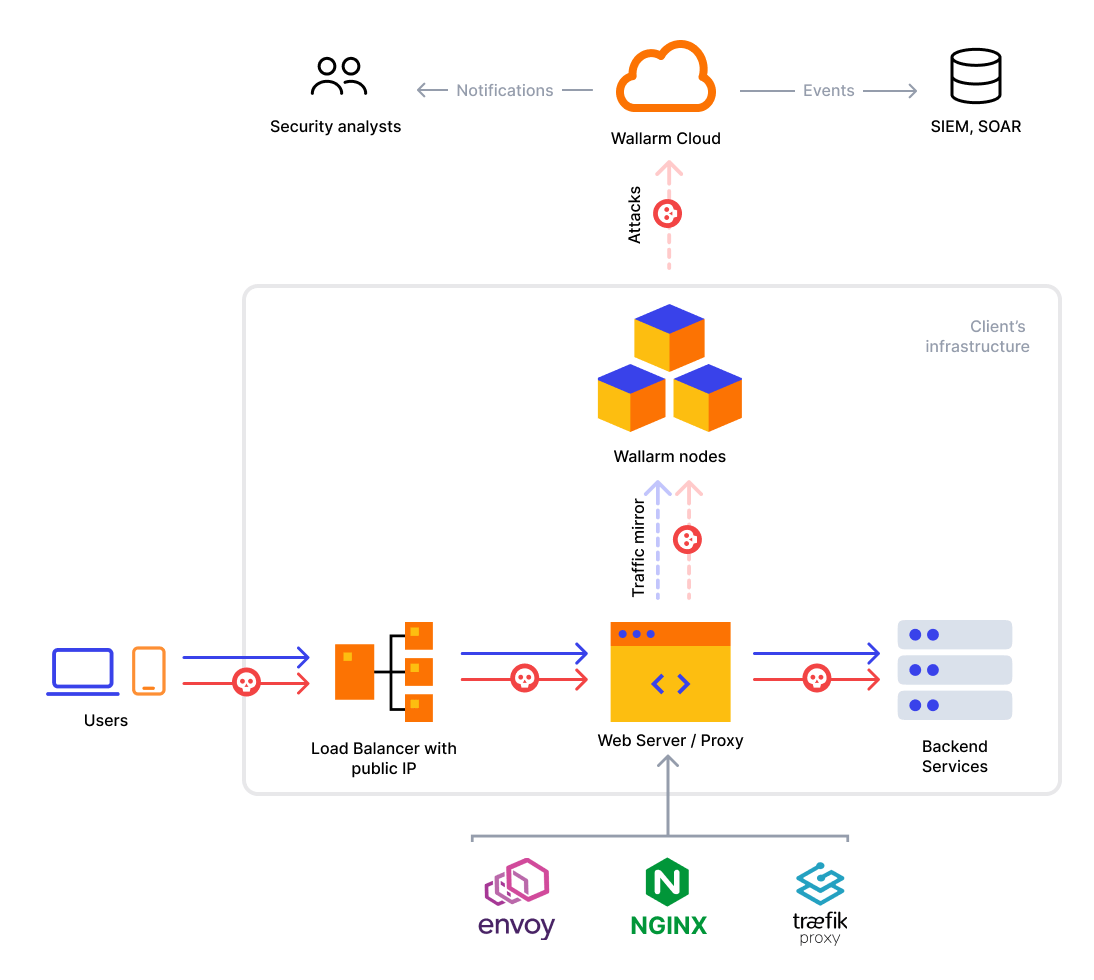Wallarm OOB للحركة المتطابقة بواسطة NGINX و Envoy وما شابه¶
تشرح هذه المقالة كيفية نشر Wallarm كحل OOB إذا اخترت إنتاج مرآة للحركة بواسطة حلول NGINX أو Envoy أو ما شابه.
يمكن تنفيذ تطابق الحركة عن طريق تكوين خادم الويب أو الوكيل أو خادم مشابه لنسخ الحركة الواردة إلى خدمات Wallarm للتحليل. مع هذا النهج، يبدو تدفق الحركة النموذجي كما يلي:
إجراء التنشيط¶
لتنشيط وتكوين Wallarm لتحليل مرآة للحركة، تحتاج إلى:
-
نشر عقدة Wallarm في بنية التحتية الخاصة بك باستخدام واحدة من الطرق التالية:
دعم تحليل الحركة المتطابقة
فقط عقد Wallarm القائمة على NGINX تدعم تصفية الحركة المتطابقة.
-
قم بتكوين Wallarm لتحليل نسخة الحركة - تحتوي التعليمات الواردة أعلاه على الخطوات المطلوبة.
-
قم بتكوين البنية التحتية الخاصة بك لإنتاج نسخة من الحركة الواردة وإرسال النسخة إلى عقدة Wallarm كمكمل للخلفية.
بالنسبة لتفاصيل التكوين، نوصي بالرجوع إلى توثيق المكونات المستخدمة في البنية التحتية الخاصة بك. نحن أدناه نقدم أمثلة التكوين لبعض الحلول الشائعة مثل NGINX و Envoy وما شابه ولكن التكوين الفعلي يعتمد على خصوصيات البنية التحتية الخاصة بك.
أمثلة التكوين لتطابق الحركة¶
أدناه هي الأمثلة على كيفية تكوين NGINX و Envoy و Traefik و Istio لتعكس الحركة الواردة إلى العقد Wallarm كجزء من الخلفية الإضافية.
NGINX¶
بدءًا من NGINX 1.13 يمكنك تطابق الحركة إلى خلفية إضافية. لتطابق الحركة في NGINX:
-
قم بتكوين الوحدة
ngx_http_mirror_moduleبواسطة تعيين توجيهmirrorفي القائمةlocationأوserver.ستعكس الأمثلة أدناه الطلبات المستلمة في
location /إلىlocation /mirror-test. -
لإرسال الحركة المتطابقة إلى عقدة Wallarm، سجل الرؤوس المراد تطابقها وحدد عنوان IP للجهاز الذي يحتوي على العقدة في
locationالتي تشير إليها التوجيهmirror.
location / {
mirror /mirror-test;
mirror_request_body on;
root /usr/share/nginx/html;
index index.html index.htm;
}
location /mirror-test {
internal;
#proxy_pass http://111.11.111.1$request_uri;
proxy_pass http://222.222.222.222$request_uri;
proxy_set_header X-SERVER-PORT $server_port;
proxy_set_header X-SERVER-ADDR $server_addr;
proxy_set_header HOST $http_host;
proxy_set_header X-Forwarded-For $realip_remote_addr;
proxy_set_header X-Forwarded-Port $realip_remote_port;
proxy_set_header X-Forwarded-Proto $http_x_forwarded_proto;
proxy_set_header X-Scheme $scheme;
proxy_set_header X-Request-ID $request_id;
}
Envoy¶
يعد هذا المثال تكوينًا لتطابق الحركة ب Envoy عبر المستمع listener الوحيد الذي يستمع إلى المنفذ 80 (بدون TLS) ويحتوي على فلتر filter واحد. يتم تحديد عناوين الخلفية الأصلية والخلفية الإضافية التي تتلقى الحركة المتطابقة في الكتلة clusters.
static_resources:
listeners:
- address:
socket_address:
address: 0.0.0.0
port_value: 80
filter_chains:
- filters:
- name: envoy.filters.network.http_connection_manager
typed_config:
"@type": type.googleapis.com/envoy.extensions.filters.network.http_connection_manager.v3.HttpConnectionManager
stat_prefix: ingress_http
codec_type: AUTO
route_config:
name: local_route
virtual_hosts:
- name: backend
domains:
- "*"
routes:
- match:
prefix: "/"
route:
cluster: httpbin # <-- link to the original cluster
request_mirror_policies:
- cluster: wallarm # <-- link to the cluster receiving mirrored requests
runtime_fraction:
default_value:
numerator: 100
http_filters:
- name: envoy.filters.http.router
typed_config:
"@type": type.googleapis.com/envoy.extensions.filters.http.router.v3.Router
clusters:
### Definition of original cluster
###
- name: httpbin
type: STRICT_DNS
lb_policy: ROUND_ROBIN
load_assignment:
cluster_name: httpbin
endpoints:
- lb_endpoints:
- endpoint:
address:
### Address of the original endpoint. Address is DNS name
### or IP address, port_value is TCP port number
###
socket_address:
address: httpbin # <-- definition of the original cluster
port_value: 80
### Definition of the cluster receiving mirrored requests
###
- name: wallarm
type: STRICT_DNS
lb_policy: ROUND_ROBIN
load_assignment:
cluster_name: wallarm
endpoints:
- lb_endpoints:
- endpoint:
address:
### Address of the original endpoint. Address is DNS name
### or IP address, port_value is TCP port number. Wallarm
### mirror schema can be deployed with any port but the
### default value is TCP/8445 for Terraform module, and
### the default value for other deployment options should be 80.
###
socket_address:
address: wallarm
port_value: 8445
Istio¶
لتطابق الحركة في Istio، يمكنك تكوين VirtualService لتطابق الطرق إما إلى النقطة النهائية الداخلية (الداخلية لـ Istio، على سبيل المثال المستضافة في Kubernetes) أو إلى النقطة النهائية الخارجية مع ServiceEntry:
-
لتمكين تطابق الطلبات داخل الكتلة (مثل: بين الوعاءات)، أضف
meshإلى.spec.gateways. -
لتمكين تطابق الطلبات الخارجية (مثل: عبر خدمة LoadBalancer أو NodePort)، قم بتكوين مكون Istio
Gatewayوأضف اسم المكون إلى.spec.gatewaysمنVirtualService. تتم تقديم هذا الخيار في الأمثلة التالية.
---
### Configuration of destination for mirrored traffic
###
apiVersion: networking.istio.io/v1beta1
kind: ServiceEntry
metadata:
name: wallarm-external-svc
spec:
hosts:
- some.external.service.tld # mirroring destination address
location: MESH_EXTERNAL
ports:
- number: 8445 # mirroring destination port
name: http
protocol: HTTP
resolution: DNS
---
apiVersion: networking.istio.io/v1alpha3
kind: VirtualService
metadata:
name: httpbin
spec:
hosts:
- ...
gateways:
### Name of istio `Gateway` component. Required for handling traffic from
### external sources
###
- httpbin-gateway
### Special label, enables this virtual service routes to work with requests
### from Kubernetes pods (in-cluster communication not via gateways)
###
- mesh
http:
- route:
- destination:
host: httpbin
port:
number: 80
weight: 100
mirror:
host: some.external.service.tld # mirroring destination address
port:
number: 8445 # mirroring destination port
---
### For handling external requests
###
apiVersion: networking.istio.io/v1alpha3
kind: Gateway
metadata:
name: httpbin-gateway
spec:
selector:
istio: ingress
app: istio-ingress
servers:
- port:
number: 80
name: http
protocol: HTTP
hosts:
- "httpbin.local"
Traefik¶
يعتمد مثال التكوين التالي على النهج dynamic configuration file. يدعم Traefik أيضًا أوضاع تكوين أخرى، ويمكنك بسهولة ضبط واحد الذي تم تقديمه لأي منهم لأنهم يحتوون على بنية مشابهة.
### Dynamic configuration file
### Note: entrypoints are described in static configuration file
http:
services:
### This is how to map original and wallarm `services`.
### In further `routers` configuration (see below), please
### use the name of this service (`with_mirroring`).
###
with_mirroring:
mirroring:
service: "httpbin"
mirrors:
- name: "wallarm"
percent: 100
### The `service` to mirror traffic to - the endpoint
### that should receive the requests mirrored (copied)
### from the original `service`.
###
wallarm:
loadBalancer:
servers:
- url: "http://wallarm:8445"
### Original `service`. This service should receive the
### original traffic.
###
httpbin:
loadBalancer:
servers:
- url: "http://httpbin:80/"
routers:
### The router name must be the same as the `service` name
### for the traffic mirroring to work (with_mirroring).
###
with_mirroring:
entryPoints:
- "web"
rule: "Host(`mirrored.example.com`)"
service: "with_mirroring"
### The router for the original traffic.
###
just_to_original:
entryPoints:
- "web"
rule: "Host(`original.example.local`)"
service: "httpbin"
